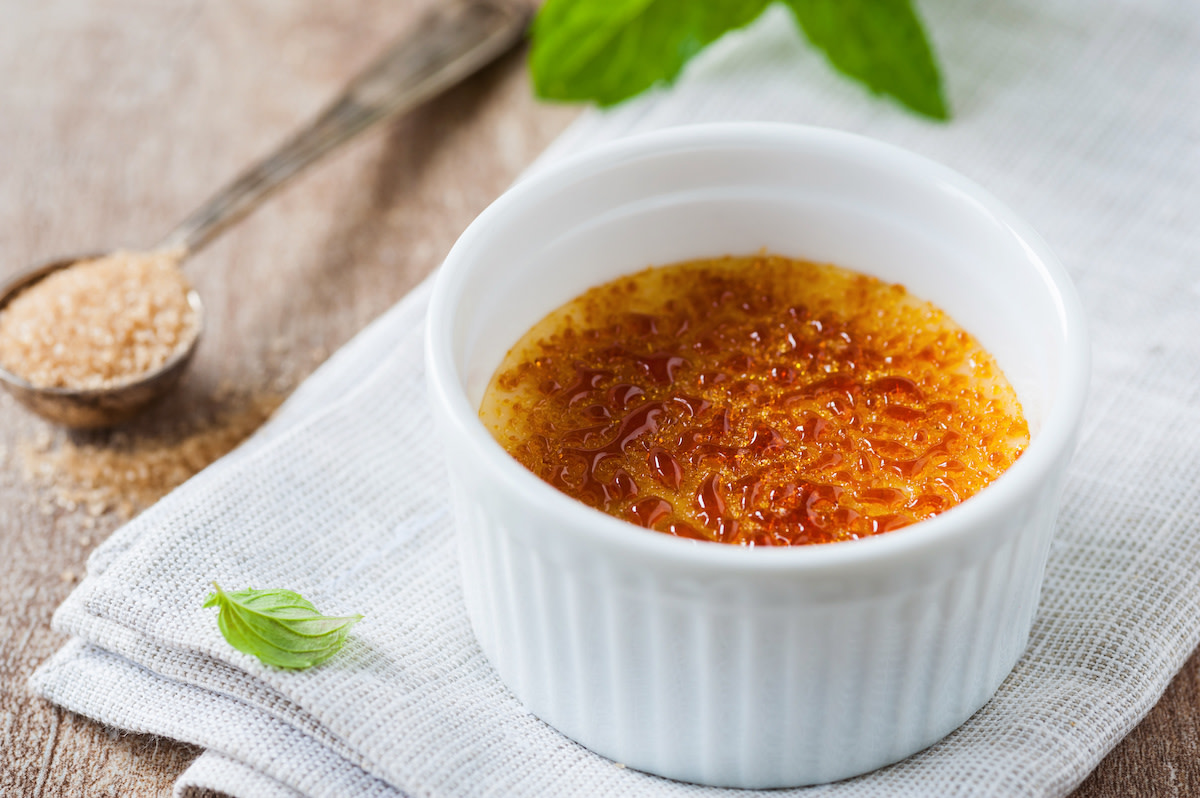Crème Brûlée Without a Torch: How to Make Easy Crème Brûlée
Written by MasterClass
Last updated: Sep 22, 2022 • 4 min read
Crème brûlée is a delicacy bursting with vanilla and caramel flavor. Learn how to make crème brûlée without a torch so you can serve this dessert alongside home-cooked meals.
Learn From the Best
What Is Crème Brûlée?
Crème brûlée is a custard-based dessert with a creamy pudding-like texture and a crunchy, caramelized top made from hardened sugar. The brûlée of crème brûlée is the browned, crisp sugar topping of the cream. Also known as Trinity cream or burnt cream, this popular French dessert uses just a few simple ingredients: heavy cream, sugar, eggs, and vanilla bean, along with a sugar topping.
Equipment Needed to Make Crème Brûlée Without a Torch
To make crème brûlée without a kitchen torch, you’ll need a set of ramekins and an oven broiler. Ramekins are circular cooking dishes that make individual portions of crème brûlée. The straight-edge sides of the ramekin allow the eggs to rise as they cook. Cooking crème brûlée with an oven broiler results in the same crunchy, caramelized effect on top you would achieve with a kitchen torch.
How to Make Crème Brûlée Without a Torch
Crème brûlée has a total cook time of about thirty minutes. Consider the following steps for making a crème brûlée recipe without a kitchen blowtorch for the first time:
- Prep the oven and ramekins. Preheat the oven to 325 degrees Fahrenheit. Place your ramekins on a large baking sheet and set the pan aside.
- Prep the ingredients. Crème brûlée uses fresh vanilla beans to create a rich, sweet flavor. Vanilla beans come in tiny pods, so use a sharp knife to cut open the pods lengthwise. If you don’t have fresh vanilla beans, you can substitute vanilla extract.
- Combine the cream ingredients. Scrape the vanilla beans and the pulp into a large pot on the stove. Add the heavy cream and salt to the vanilla beans, then cook the mixture on medium heat until it boils. Remove the pot from the stovetop and set it aside to cool.
- Mix the eggs and sugar. In a medium bowl, combine the eggs and sugar. Whisk the mixture until the eggs and sugar become pale yellow.
- Temper the eggs. To add an extra layer of protection against making scrambled eggs, temper the yolks by whisking them together with a small portion of the warmed cream before introducing the egg mixture to the rest of the ingredients.
- Pour the mixture into ramekins. Continue to whisk together the cream and the egg yolks. Divide and pour the custard into your set of ramekins. If your custard is thick and lumpy, strain it over a large measuring cup before pouring it into the ramekins.
- Bake the crème brûlée. Place a baking pan with the cookware on it in the preheated oven. Before closing the oven door, pour boiling water on the baking dish to create a water bath for the ramekins. The hot water keeps the oven moist, preventing the crème brûlée from cracking. Cook the crème brûlée for about thirty minutes or until the custard sets and has a jiggly consistency.
- Cool and refrigerate the ramekins. Wearing oven mitts, remove the baking sheet from the oven and set the ramekins on a cooling rack. Once the hot cream has cooled, refrigerate the baked custard for at least two hours.
- Add the sugar. Remove the ramekins from the refrigerator and allow them to sit at room temperature for thirty minutes. Sprinkle the sugar over the top of the custard to create a thin layer of sugar.
- Broil the crème brûlée. Set the oven to broil and the temperature to 500 degrees Fahrenheit. Place the ramekins on the top shelf and let them broil until they become lightly golden or for about one minute. Monitor the crème brûlée to prevent it from overcooking and developing burnt sugar pieces. Broiling creates the signature look of crunchy, caramelized sugar on top of the crème brûlée.
3 Tips for Making Crème Brûlée Without a Torch
The below tips will help you make a decadent crème brûlée with a creamy custard and crispy sugar crust.
- 1. Avoid over-whisking. Introducing too much air to the crème brûlée mixture can be detrimental to the final texture of the desert. Just whisk the cream enough to fully incorporate the ingredients.
- 2. Choose the right sugar topping. Although you can use dark sugars, such as demerara or brown sugar, white sugar works best for caramelizing the top. Dark sugars, especially brown sugar, are too soft and burn easily. Using alternative forms of sugar would also change the overall flavor of the dessert.
- 3. Use room temperature eggs. Cold eggs that come directly from the fridge will likely result in scrambled or curdled eggs after you introduce them to heat. Instead, allow the eggs to warm to room temperature before whisking the ingredients together.
Want to Learn More About Baking?
Become a better baker with the MasterClass Annual Membership. Gain access to exclusive video lessons taught by the world’s best, including Dominique Ansel, Joanne Chang, Gordon Ramsay, Chef Thomas Keller, Mashama Bailey, and more.
